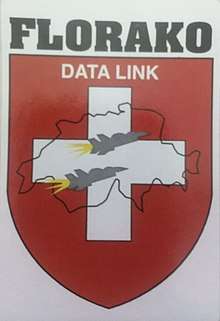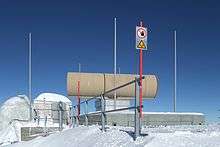FLORAKO
FLORAKO is a Swiss radar system for military and civil aviation. The acronym stands for FLORIDA radar replacement air radar system capable communication system (in German: FLORIDA Radarersatz Radarluftlagesystem Kommunikationssystem) in the initial phase of the project meant the name FLORES RALUS KOMSYS and emerged from the project name of the sub-systems. There are four surface to air missile tubes located on the site.[1]

Procurement
The FLORAKO System was Introduced on 2 February 2004 by the Swiss Air Force. It replaces the older FLORIDA Airspace monitoring and management system, which dated back from the 1960s. The acquisition costs amounted to approximately 728 million Swiss francs. The four radar sites [2] Mount Pilatus,[3] Scopi,[4] Weisshorn and Weissfluh[5] are classified and therefore not publicly available. Supplier of the system was Thales Raytheon Systems, a joint venture between Raytheon Company and Thales Group.[6] Thales Raytheon Systems was also involved of the further expansion of the system that was delivered in 2008 and still carries out further upgrades of the system.[7] In January 2017, Thales was commissioned by Armasuisses to modernize the FLORAKO system, extending its operational capabilities through to 2030.[8]
Technology



The FLORAKO radar system is used for air defense. It consists of an air surveillance radar in semiconductor technology, and a secondary radar subsystem for simulation. The 3D objective FLORAKO provides real-time information, correlated with the secondary radar data over a wide detection area. The FLORAKO constantly works with 15 Rpm rotating phased array antenna. At least one of these Command, Control, and Communications (C3) facilities is always connected to the Air Defense & Direction Center (the ADDC or air ops center) at Dübendorf and fully operational on-line on a 24/7 basis, controlling Swiss airspace. Depending on the international situation, more facilities will be manned up; in case of crisis or war (ADDC and 4 facilities operational) the coverage will be extended far beyond the Swiss boundaries. Each of these AirOps facilities is capable of making all battle management decisions in case the ADDC or the other AirOps facilities might be eliminated.[9]
Operational lifetime of this hi-tech system is guaranteed by its manufacturers for at least 25 years. The system consists of:
- A communication system KOMSYS. Integrating element of all geographically divided parts of the FLORAKO system uniting speech, data communications, and system commands in a single data network. So it is possible with the IDS / Link-16 to exchange radardatas with the FLORAKO and the Link-16 equipped aircraft. so a fighter Pilot has a 360° Radarcoverage or a Fighter can transmit his radartracks piket up in a narrow valley who is in the radarshadow of the FLORAKO radars. The Swiss Link 16 and FLORAKO can, if needed, collaborate with foreign Link-16 equipped aircraft (for e.g. French Boeing E-3 Sentry AWACS), provided a similar MIDS (Multifunctional Information Distribution System) keycode is used.[10]
- A radar station FLORES. Consisting of standard high-power search radars, advanced radars (search mode, high-update ratio, and special functions), and civil authority monopulse secondary radars. The 4 radar stations are the main data sources and are complemented by existing military and civil radar data.
- A radar layer-system RALUS. Translating the data automatically into flight paths and producing a complete civil-military air picture for all authorities.
- A warning message system LUNAS-EZ. AirOps Centers are the combining factors between the FLORAKO-system with real-time data (air picture, planning, and environmental data) and its military users. Workstations are identically configured and built accordingly to latest ergonomics, state of the art visual colour hi-res technology, menu guidance, and known user environment. The Dübendorf Air Defense & Direction Center – as well as the air operations units in the Alps – are equally equipped, thus assuring full-time operational redundancy in
- producing the actual airpicture
- permanent defence of Swiss airspace
- early warning
- command and control
- air policing
- coordination of civil and military air traffic
- The Military-Civil Airspace Management System MICAMS. This secondary system provides a computing backup for flexible airspace use for both civil and military flight security.
The radar system may eventually be completed by mobile TAFLIR (TAktische FLIeger Radars - Tactical Flight Radars). These AN/MPQ-64 radars are a variant of the Northrop Grumman AN/TPS-75 and are deployable in areas of difficult terrain or where specific coverage is needed. Peacetime TAFLIR deployment locations are at Dübendorf and Emmen. In time of crisis or at war they can be deployed anywhere.[9] The FLORAKO is a modified version of the requirements for Swiss radars Master A and Master M from Thales. In addition to the data of the FLORAKO radar stations and the data of the mobile TAFLIR radars and civil Skyguide radar data can be fed into the FLORAKO system. The armasuisse, an independent branch of the MoD, operates a special equipped Pilatus PC-12 with the civil immatriculation HB-FOG to calibrate the radars, MIDS Link-16 and Radiocomunication of the FLORAKO system.
Specifications Master M
- frequency range = S-band
- pulse repetition = classified
- pulse repetition frequency = classified
- Transmission time (PW) = classified
- reception time = classified
- dead time = classified
- pulse power = classified
- Average power = classified
- Displaying Distance = up to 470 km
- Distance resolution = 200 m
- opening angle = 3 °
- number of hits = Monopulse radar
- Antenna rotation = 4 s
Specifications Master-A
- frequency range = S-band
- pulse repetition = classified
- pulse repetition frequency = ?
- Transmission time (PW) = classified
- reception time = classified
- dead time = classified
- pulse power = classified
- Average power = classified
- Displaying Distance = up to 370 km
- Distance resolution = 220 m
- opening angle = classified
- number of hits = Monopulse radar
- Antenna rotation = 4 s
References
- "FLORAKO website (German only)". Archived from the original on 11 January 2013. Retrieved 3 May 2013.
- Force Report: Swiss Air Force – Alpine Warriors. In: Air Forces Monthly magazine in association with Air Forces Intelligence - The Online Air Arms Database, September 2009, page 68.
- Pilatus, Airdefense Command & Control unit, Info page at zone-interdite.net, retrieved May 2, 2012
- Scopi, Airdefense Command & Control unit, Info page at zone-interdite.net, retrieved May 2, 2012
- Weissfluh, Airdefense Command & Control unit, Info page at zone-interdite.net, retrieved May 2, 2012
- Florako, the Swiss air forces’ new air defense and air operations command-and-control system, went live at the start of February. Archived 15 February 2015 at the Wayback Machine ThalesRaytheonSystems press release, March 24, 2004
- ThalesRaytheonSystems receives $20M FLORAKO framework contract from Switzerland Archived 15 February 2015 at the Wayback Machine Raytheon Company press release, March 7, 2011
- Tomkins, Richard (19 January 2017). "Swiss air force upgrading surveillance radars". UPI. Archived from the original on 22 January 2017.
Master air defense radars of the Swiss air force are to be modernized by Thales to extend their operational capabilities until the year 2030. The work is part of the Swiss government's FLORAKO radar modernization program. It was commissioned by Armasuisse, the Swiss armaments procurement agency, and is worth more than $79 million.
- Air Forces Monthly, p. 68
- SkyNews.ch Magazin 5May2007
External links
| Wikimedia Commons has media related to FLORAKO. |